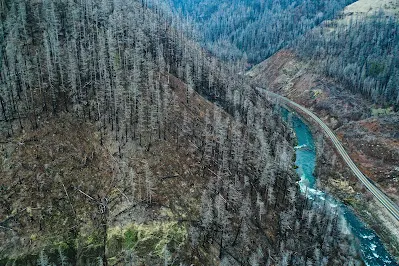Acid rain might sound like something out of a science fiction novel, but it’s a very real environmental issue that has been affecting ecosystems around the world for decades. While rainwater is typically neutral in pH, when pollution from vehicles, industries, and power plants mixes with the atmosphere, it can form sulfuric and nitric acids, which fall back to Earth as acid rain.
So, what does this mean for our environment? Let’s break it down and explore the effects of acid rain on our soil, water, and air quality, along with some potential solutions to this growing problem.
🌧️ What Is Acid Rain?
Before we dive into the environmental effects, let’s first understand what exactly acid rain is. Acid rain refers to any form of precipitation (rain, snow, fog, or dust) that has a pH level of less than 5.6. This is much more acidic than normal rain, which has a neutral pH of around 7.
The primary culprits behind acid rain are sulfur dioxide (SO₂) and nitrogen oxides (NOₓ), which are released into the atmosphere by industrial processes, burning fossil fuels, and vehicle emissions. These chemicals react with water vapor, oxygen, and other chemicals in the air to form sulfuric and nitric acid, which then fall back to Earth as acid rain.
🌍 Soil Degradation
One of the first places acid rain hits is the soil. When acid rain falls on the ground, it lowers the pH of the soil, making it more acidic. This can have serious consequences for plant life and the entire ecosystem.
Nutrient Leaching: As soil becomes more acidic, it loses essential nutrients such as calcium, magnesium, and potassium. This nutrient deficiency weakens plants and makes them more vulnerable to diseases, pests, and extreme weather conditions.
Heavy Metal Mobilization: Acid rain can also release toxic metals like aluminum from the soil into groundwater. These metals are harmful to plants, animals, and even humans when they enter the water supply.
In short, acid rain makes it harder for plants to thrive, and can lead to a domino effect where animals and humans are impacted as well.
🌲 Forests and Vegetation Damage
Acid rain doesn’t just harm the soil—it can directly damage plant life. Trees and other vegetation are particularly vulnerable to acid rain, as it can weaken them over time. Here’s how:
- Leaf and Needle Damage: Acid rain can cause leaves and needles to develop visible scars, become discolored, and eventually die. This affects trees like evergreens, which are particularly sensitive to acid rain.
- Root Damage: The acidity in the soil can prevent tree roots from absorbing water and nutrients, further weakening the plant. Over time, this leads to stunted growth and even death of entire forests.
- Impact on Biodiversity: As trees die off or are weakened by acid rain, other species of plants and animals that depend on these forests also suffer. This can lead to biodiversity loss, disrupting entire ecosystems.
🐟 Waterway Contamination
Acid rain doesn’t just affect the land; it can also harm bodies of water, such as lakes, rivers, and streams. The acidification of water sources can lead to several significant problems:
- Aquatic Life Disruption: Many aquatic organisms, including fish, amphibians, and insects, are highly sensitive to changes in pH. When the pH level of water drops below a certain threshold, it can be deadly for these creatures. Species such as trout and salmon are particularly vulnerable.
- Food Chain Disturbance: The death of aquatic species can have a ripple effect throughout the food chain, impacting predators like birds and larger fish.
- Decrease in Biodiversity: Acid rain can reduce the diversity of aquatic life, making ecosystems less resilient to other environmental threats.
🌆 Impact on Human Health
While acid rain primarily affects the environment, humans are not entirely immune to its effects. The pollutants that cause acid rain—sulfur dioxide (SO₂) and nitrogen oxides (NOₓ)—can have direct health consequences:
- Respiratory Problems: These pollutants can contribute to the formation of fine particulate matter and ground-level ozone, which can irritate the lungs and worsen conditions like asthma and bronchitis.
- Drinking Water Contamination: The presence of harmful metals and chemicals in water sources due to acid rain can lead to contamination, which poses a risk to drinking water quality.
🌞 The Role of Regulations and Solutions
While acid rain is a significant environmental issue, there is hope. Governments and industries have been working to reduce the emissions that cause acid rain through cleaner technologies and policies. Some solutions include:
- Emissions Regulations: Governments worldwide, including the United States and the European Union, have set regulations to limit emissions of sulfur dioxide and nitrogen oxides from power plants and vehicles.
- Switching to Renewable Energy: Using alternative energy sources such as solar and wind can help reduce the reliance on fossil fuels, which are a major source of the pollutants that cause acid rain.
- Natural Remedies: In some areas, scientists have also been experimenting with adding limestone to acidified soils and water sources to neutralize the acidity.
🛍️ Related Amazon Products
- 🌿 Air Purifiers for Home – Keep your indoor air clean and reduce pollutants.
- 🌱 Eco-Friendly Cleaning Products – Use non-toxic products to help reduce harmful chemicals in the environment.
- 🏞️ Water Filters for Home – Protect your drinking water from contaminants.
🌿 Related Posts You Might Find Interesting:
- Benefits of Supporting Eco-Conscious Brands
- The Future of Electric Cars in Eco-Conscious Living
- How to Recycle Construction Waste During Renovations
- The Role of Wind Energy in Home Sustainability
These are the questions the post answers:
- What are the environmental impacts of acid rain?
- How can acid rain affect human health and the environment?
For personalized services and content creation, please contact me at admin@healthyspell.com.

0 Comments
Post a Comment